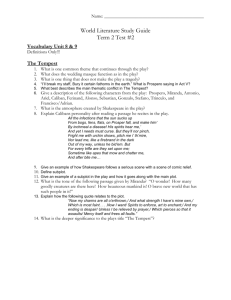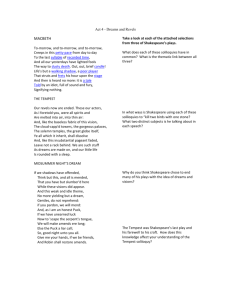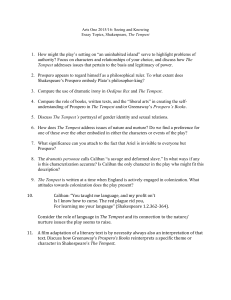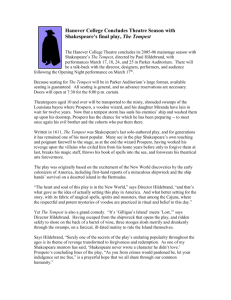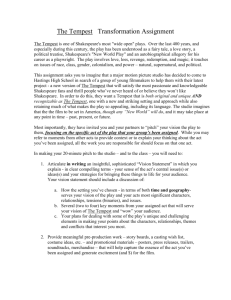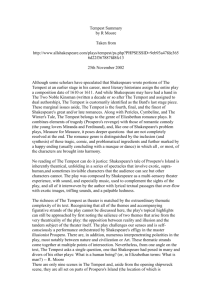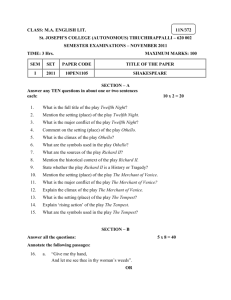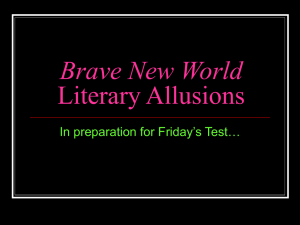Access Points: Inviting Students into Complex Text
advertisement
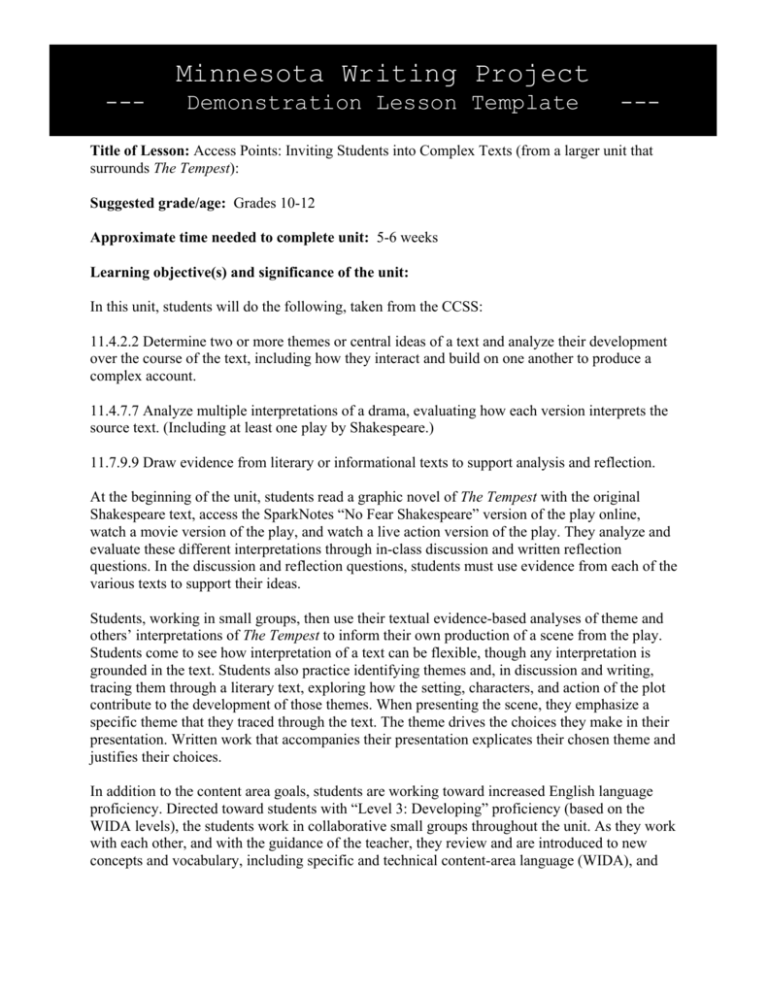
Minnesota Writing Project --- Demonstration Lesson Template --- Title of Lesson: Access Points: Inviting Students into Complex Texts (from a larger unit that surrounds The Tempest): Suggested grade/age: Grades 10-12 Approximate time needed to complete unit: 5-6 weeks Learning objective(s) and significance of the unit: In this unit, students will do the following, taken from the CCSS: 11.4.2.2 Determine two or more themes or central ideas of a text and analyze their development over the course of the text, including how they interact and build on one another to produce a complex account. 11.4.7.7 Analyze multiple interpretations of a drama, evaluating how each version interprets the source text. (Including at least one play by Shakespeare.) 11.7.9.9 Draw evidence from literary or informational texts to support analysis and reflection. At the beginning of the unit, students read a graphic novel of The Tempest with the original Shakespeare text, access the SparkNotes “No Fear Shakespeare” version of the play online, watch a movie version of the play, and watch a live action version of the play. They analyze and evaluate these different interpretations through in-class discussion and written reflection questions. In the discussion and reflection questions, students must use evidence from each of the various texts to support their ideas. Students, working in small groups, then use their textual evidence-based analyses of theme and others’ interpretations of The Tempest to inform their own production of a scene from the play. Students come to see how interpretation of a text can be flexible, though any interpretation is grounded in the text. Students also practice identifying themes and, in discussion and writing, tracing them through a literary text, exploring how the setting, characters, and action of the plot contribute to the development of those themes. When presenting the scene, they emphasize a specific theme that they traced through the text. The theme drives the choices they make in their presentation. Written work that accompanies their presentation explicates their chosen theme and justifies their choices. In addition to the content area goals, students are working toward increased English language proficiency. Directed toward students with “Level 3: Developing” proficiency (based on the WIDA levels), the students work in collaborative small groups throughout the unit. As they work with each other, and with the guidance of the teacher, they review and are introduced to new concepts and vocabulary, including specific and technical content-area language (WIDA), and must comprehend and communicate ideas in a manner consistent with American academic discourse. Summary: This unit happens in the second half of the year, at the end of the second term in a trimester system. Prior to this unit, the students have received instruction on identifying, understanding, and analyzing theme and effective group communication. Right before this, the students study the concept of “perception” and explore how authors affect our perception of the world with their writing, which carries over into this unit. This unit builds toward an assessment of students’ understanding of theme in literature and ability to communicate their ideas efficiently and effectively in speaking and writing, which students demonstrate through a final two-week-long group project, facilitated by the teacher, culminating in the students’ presentation of their chosen scenes (live or recorded) with accompanying written pieces. This is the first lesson in that unit. 1) Start by collecting students’ ideas about Shakespeare. What comes to mind? (Write somewhere visible.) 2) Show The Tempest movie trailer. (Note: Point out the words that flash across the screen. The words name themes. Also point out that Prospero is the main character, and that though he is male in the original play, she was “Prospera,” female, in the movie trailer— and that’s okay, because the play can be interpreted in a number of different ways.) 3) Give the students an opportunity to react to the trailer. How does the trailer compare to what they expect from Shakespeare? 4) Have them explore the book (preview the text). The first few pages have a list of characters and a little bit of background information—What do they notice? What questions do they have? (This is good think-pair-share work.) 5) Analyze the first panel of the book, which shows Prospero raising his staff and the ships embroiled in the tempest: What can we infer about this character from this panel? What can we infer if we include information from the trailer that we watched? (I have them do this with their think-pair-share partner.) [Skipping to a later lesson] 6) Read Act I, Scene 2 in small groups, using specific group roles. Students will read it in the comic book with access to the online No Fear Shakespeare side-by-side version of the text for help with interpretation. 7) Show Act I, Scene 2 from the Cimolino/McAnuff/Plummer live action recording of The Tempest. 8) Show Act I, Scenes 2 from the Taymor interpretation of The Tempest. 9) Have the group discuss what they noticed in each of these portrayals. (This could be done a number of ways.) 10) Have them write a reflection about the character of Prospero using evidence from the text to analyze the range of ways they are seeing this character be interpreted. Some questions might include: How was he/she portrayed in each of the interpretations, and how is the character the same or different in each? What affect does that have on the reader/viewer? How does Prospero’s relationship with Miranda change in each portrayal? Resources for the Unit: 1:1 laptops or iPads, but a computer lab would work Access to GoogleDocs Cellphones with voice recording capability (optional) Farewell to Shakespeare: Final Project materials and rubrics (teacher-created) No Fear Shakespeare (SparkNotes): http://nfs.sparknotes.com/tempest/ Projector and screen (SmartBoard or similar technology, if possible, so that it is easy to stop and start or quickly move to another resource and back) The Tempest Movie Trailer (on YouTube): http://youtu.be/opjhs1mgd1s Shakespeare Uncovered: The Tempest on PBS.org: http://www.pbs.org/wnet/shakespeareuncovered/video/ Shakespeare, William. The Tempest: The Graphic Novel. Ed. Clive Bryant. Towcester: Classical Comics, 2009. Print. The Tempest. Dir. Antoni Cimolino and Des McAnuff. Perf. Christopher Plummer. Entertainment One, 2012. DVD. The Tempest. Dir. Julie Taymor. Perf. Helen Mirren and Russell Brand. Touchstone Home Entertainment, 2011. DVD. “The Virtual Globe” online interactive: http://www.english.cam.ac.uk/converse/movies/no_sound_globe.swf Video cameras and video editing software (optional) Possible extensions or adaptations for different purposes/student needs: Students have access to rich multi-media resources. The teacher should monitor students’ comprehension and progress and suggest specific resources as needed. In the event that a student still struggles to follow the text, even with the graphic novel, there are also “Plain Text” and “Quick Text” versions available through Classical Comics. However, the advantage of the original text is that it is comparable to the movie and play versions, so the student can follow along. In addition, access to “No Fear Shakespeare” gives students the option of comparing the original text and a plain text version side by side, while the illustrations in the graphic novel support their comprehension. Subtitles for the movie and play versions are also useful. For additional information, contact: laurastelter@gmail.com
